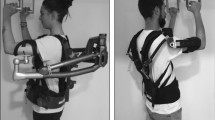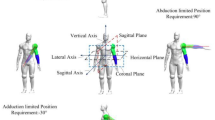Abstract
Objective to investigate the effect of a passive shoulder exoskeleton on full body musculoskeletal loading during a wiring and lifting task above shoulder height. Methods: Three participants performed a wiring and lifting task with 10 kg above shoulder height with and without âssive shoulder exoskeleton. OpenSim was used to calculate kinematics, kinetics, muscle forces and joint contact forces at the shoulder and L5. Results: Kinematics did not change during the lifting task but kinematics did change for two out of the three participants during the wiring task while wearing the exoskeleton. Moreover, joint moments and muscle forces in the shoulder were decreased. In addition, compression forces at L5 were decreased but shear forces were increased while wearing the exoskeleton during both tasks. Conclusion: Considering that this is preliminary data, this exoskeleton could decrease the risk of developing work-related shoulder disorders in specific tasks.
Access provided by Autonomous University of Puebla. Download conference paper PDF
Similar content being viewed by others
1 Introduction
Repetitive movements are commonly reported by the European working population (61%) [1]. As a result, 30–56% of this population indicates to have suffered from an upper limb disorder in the past 12 months [1]. Ergonomic interventions do not significantly reduce the risk of developing upper limb disorders and the need for flexibility of the worker is high. As a result, the industry has high interest in exoskeletons in order to decrease the risk of developing work-related musculoskeletal disorders (WMSDs) [2]. Currently, main focus is on passive exoskeletons as they are cheaper and lighter to work with [2] and have been proven to be effective in decreasing muscle activations and compression forces of the lower back [3] and shoulder [4]. However, while wearing an exoskeleton, musculoskeletal load could shift from the assisted joint to the non-assisted joints and lead to new and other WMSDs [2]. This shift in musculoskeletal load is not commonly analyzed by the lack of full-body analysis [2,3,4]. Therefore, this study analyzed the effects of a passive shoulder exoskeleton equipped with elastic elements to store and release energy when needed, developed within the Exo4Work project, on the full body musculoskeletal load using a detailed full-body musculoskeletal model in OpenSim [5].
2 Material and Methods
Three healthy participants (EXO01, EXO02, and EXO03) pulled laces through holes at 50 cm above shoulder height (overhead wiring task) and a lifting task during which the participant had to lift a 10 kg box from shoulder height to 50 cm above shoulder height. Both tasks were performed with and without a passive shoulder exoskeleton, developed for the Exo4Work project (FWO–grant no S000118N) (exo and non-exo condition respectively) which cannot be described due to patents pending. Marker trajectories and ground reaction forces were measured synchronously in order to calculate full-body kinematics, kinetics, muscle forces and joint contact forces using the OpenSim workflow [5]. The full-body OpenSim model used, combined a lower limb model, an articulated spine model and a detailed shoulder model [6, 7]. In addition, the mass of the exoskeleton (3.8 kg) was taken into account by adding an extra body of 3.8 kg to the model at the location of the exoskeletons center of mass. The assistance given by the exoskeleton was applied in the model as a torque assistance, calculated at each time frame based on the measured elastic elements deformation and its stiffness. This assistance was applied to the humerus and the torso. In order to evaluate the exoskeleton’s effect per participant on the muscle forces and joint contact forces, the mean of the integrated muscle forces and joint contact forces was calculated per participant and per condition. The kinematics and kinetics are visualized in Figs. 1a, b and 2a, b. The difference in muscle and contact forces at L5 between the two conditions is visualized in Figs. 1a, b, c, and d and 2a, b, c, and d, with positive values indicating a reduction in muscle or joint contact forces while wearing the exoskeleton. No statistical analyses were performed due to the limited number of participants but results were analyzed per participant.
3 Results
During the lifting task, kinematic differences between the exoskeleton (solid lines) and without exoskeleton condition (dashed lines) are rather small. But, shoulder flexion moments were reduced during the lifting phase while wearing the exoskeleton. This resulted in lower muscle efforts in the shoulder and compression forces on L5 during the exoskeleton condition as shown by the positive values in Fig. 1c, d. However, shear forces on L5 were increased while wearing the exoskeleton. The magnitude of the exoskeleton effects was variable between participants but a decrease in musculoskeletal load was observed for all participants.
a Shoulder flexion and extension angle, b Shoulder moments, c Difference in muscle forces during non-exo condition and exo condition of the m. bicpes longus, biceps brevis deltoideus medius, trapezius descendens, pectoralis major, coracobrachialis d shear and compression forces at L5 during the lifting task with 10kg. The blue, red and green colors are indicating the different particpants (in all 4 subplots) as the solid line (−) is indicating the exoskeleton condition as the dashed line (—) is indicating the non-exo condition
During the wiring task, a decreased flexion angle is observed for the participants EXO02 (red) and EXO03 (green) as seen in Fig. 2a. Shoulder flexion moments were decreased for all participants. This resulted in decreased muscle forces and compression forces as described for the lifting task. Again, muscle forces in the shoulder and compression forces on L5 were decreased but shear forces on L5 were increased while wearing the exoskeleton. In contrast to the lifting task, the first participant (EXO01, blue) experienced the highest positive effects while wearing the exoskeleton as during the lifting task the third participant (EXO03, green) experienced the largest effects.
a Shoulder flexion and extension angle, b Shoulder moments, c Difference in muscle forces during non-exo condition and exo condition of the m. bicpes longus, biceps brevis deltoideus medius, trapezius descendens, pectoralis major, coracobrachialis d shear and compression forces at L5 during the lifting task with 10kg. The blue, red and green colors are indicating the different particpants (in all 4 subplots) as the solid line (−) is indicating the exoskeleton condition as the dashed line (—) is indicating the non-exo condition
4 Discussion
The developed passive shoulder exoskeleton is decreasing joint moments and muscle forces thereby decreasing musculoskeletal loading in the shoulder during the wiring and in the lifting task. In addition, compression forces at L5 were lowered but shear forces were increased during both tasks. As the exoskeleton is not limiting the kinematics of the shoulder and decreasing the musculoskeletal load, the exoskeleton can be considered a good ergonomic intervention in order to decrease the risk on developing WMSDs for the shoulder joint. Moreover, musculoskeletal load did not shift from the shoulder to the lower back as compression forces at L5 were not increased. This could be due to the fact that the mass of the exoskeleton is located at the back, posterior of the L5 vertebrae. However, shear forces did increase while wearing the exoskeleton which is considered a negative effect but this negative effect is rather small. Further full body analyses will show the effects on the full body musculoskeletal load while wearing the exoskeleton. However, multiple joint analyses are performed for this study but are not presented in this abstract.
Moreover, all participants experienced a reduction in shoulder moments and muscle forces but the magnitude of the effects were variable between participants and even between the different tasks. This variability could be due to the time of adaption to the exoskeleton but no evidence could support this statement.
5 Conclusion
Considering that this is preliminary data, the developed passive shoulder exoskeleton is decreasing musculoskeletal load in the shoulder and did not transfer this musculoskeletal load to the lower back during a lifting and wiring task. The presented methods could be used to investigate the effects of any exoskeleton on full body musculoskeletal load.
References
EU-OSHA European Agency for Safety and Health at Work, in Sixth European Working Conditions Survey—Overview Report (2017 update), p. 164, https://doi.org/10.2806/422172.
M.P. de Looze, T. Bosch, F. Krause, K.S. Stadler, L.W. O’Sullivan, Exoskeletons for industrial application and their potential effects on physical work load. Ergonomics 59(5), 671–681 (2016). https://doi.org/10.1080/00140139.2015.1081988
A.S. Koopman, I. Kingma, G.S. Faber, M.P. de Looze, J.H. van Dieën, Effects of a passive exoskeleton on the mechanical loading of the low back in static holding tasks. J. Biomech. (2018). https://doi.org/10.1016/j.jbiomech.2018.11.033
I. Pacifico et al., Experimental evaluation of the proto-MATE, a novel ergonomic upper-limb exoskeleton for reducing the worker’ s physical strain (2019)
S.L. Delp et al., OpenSim: Open source to create and analyze dynamic simulations of movement. IEEE Trans. Biomed. Eng. 54(11), 1940–1950 (2007). https://doi.org/10.1109/TBME.2007.901024
M. Christophy, N.A.F. Senan, J.C. Lotz, O.M. O’Reilly, A Musculoskeletal model for the lumbar spine. Biomech. Model. Mechanobiol. 11(1–2), 19–34 (2012). https://doi.org/10.1007/s10237-011-0290-6
K.R.S. Holzbaur, W.M. Murray, S.L. Delp, A model of the upper extremity for simulating musculoskeletal surgery and analyzing neuromuscular control. Ann. Biomed. Eng. 33(6), 829–840 (2005). https://doi.org/10.1007/s10439-005-3320-7
Acknowledgments
This research was funded by Exo4Work, SBO-E-S000118N.
Author information
Authors and Affiliations
Corresponding author
Editor information
Editors and Affiliations
Rights and permissions
Copyright information
© 2022 The Author(s), under exclusive license to Springer Nature Switzerland AG
About this paper
Cite this paper
van der Have, A., Van Rossom, S., Rossini, M., Jonkers, I. (2022). Effect of a New Passive Shoulder Exoskeleton on the Full Body Musculoskeletal Load During Overhead Work. In: Moreno, J.C., Masood, J., Schneider, U., Maufroy, C., Pons, J.L. (eds) Wearable Robotics: Challenges and Trends. WeRob 2020. Biosystems & Biorobotics, vol 27. Springer, Cham. https://doi.org/10.1007/978-3-030-69547-7_27
Download citation
DOI: https://doi.org/10.1007/978-3-030-69547-7_27
Published:
Publisher Name: Springer, Cham
Print ISBN: 978-3-030-69546-0
Online ISBN: 978-3-030-69547-7
eBook Packages: EngineeringEngineering (R0)






